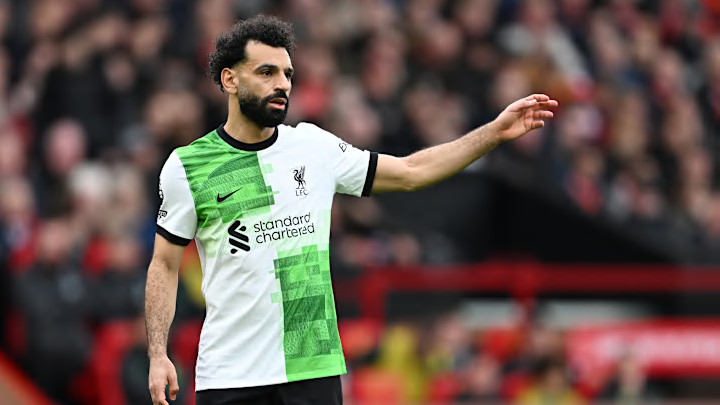With seven matches left to end the 2023/24 Premier League season, the suspense in the title race still exists while Man City and Arsenal are rallying against Liverpool.
Wrapping up the latest match week, Liverpool is now facing the biggest challenge of preserving their lead after Arsenal tops it by the goal-difference advantage.
However, it seems like Liverpool still has to learn its lessons after thrillingly tying Man United 2-2 on Sunday, making the whole team taste like a bitter loss as they didn't finish the universally-expected revenge.
Taking a look at the entire season thus far, Liverpool hasn’t beaten United despite being capable of dominating other low-ranked teams, including a frustrating loss in the FA Cup that forced the Reds to drop the ambition of winning a quadruple.
Why did Liverpool struggle with United and what can they learn from it?
Defense, a platitude of Liverpool
Although Jurgen Klopp put four defenders in his formation entering matches as usual, the offensive-oriented Liverpool has got accustom to moving its line toward the front, leaving a larger space at the back.
The opening minute of Sunday's battle shows the evidence when Man United was able to make a simple comeback with fewer passes (though Alejandro Garnacho’s later kick was called offside).
Despite dominating the first half, the Reds did not put away their rivals and conceded one goal as the result of an errant Jarrell Quansah pass, resulting in a 40-yard lob shot by Bruno Fernandes.
The mistake directly cost Liverpool, but It’s unfair to blame the 21-year-old youngster who has just 11 Premier League appearances so far. To be precise, Liverpool failed to react as fast as possible once the opponent regained possession as the defensive line couldn’t retreat on time.
At least, the goalkeeper Caoimhin Kelleher was apparently not ready for the shot, standing uncontested a box away from the net.
Moreover, Liverpool didn’t offer Man United a more intensive defense, giving the room for the opponent to make long passes.
Turning to the second half, United delivered several intimidating crosses that penetrated the box, showing Liverpool’s inability to clear the danger in the air. Although the bending strike by United’s rising star Kobbie Mainoo was sensational, Liverpool should have contracted a little bit more to block the shot out.
Man United’s Rare Resilience Against the Red
Yes, it’s rare. It’s weird that United showcased its resilience when it comes to combating Liverpool. Throughout the season, the Red Devils have been likely to succumb earlier when they battle top teams or even get hammered by the middle-class but solid teams in the league.
Even they stumbled to handle teams from lower divisions in the League Cup’s midpoint. But they show no mercy to Liverpool without rhyme or reason.
During the first meeting of the season, Liverpool swallowed a goalless tie even though it registered 34 shots. Having the then-captain Scott McTominay, veteran Johnny Evans, and a revamped Andre Onana to lead its defensive prowess,
Man United luckily survived Liverpool’s endless attack. Turning to the second round in the FA Cup Quarterfinal, Liverpool surprisingly dropped 3-4 due to its defensive frailties.
No matter what can explain United’s temporary bounceback that pinpoints Liverpool, the team for now should either learn from lessons or stay alert. The miracle is not guaranteed, Liverpool could have dropped more matches if they didn’t tighten themselves up while trailing.
Emerging Problem: Missing Chances
Again, tying a match with plenty of shot attempts feels like a loss for Liverpool. Liverpool had 3.6xG against United which only marked 0.7, forfeiting 26 shots of the match.
The issue of missing chances was revealed after the season’s midway when Liverpool couldn't set the tone early.
The statistics demonstrate that Liverpool has the most shots (620) this season but ranks 11th in on-target percentage (32.9%). Meanwhile, It also consists of the most shot-created actions (1104) and xG (70.8).
“We should’ve been 2-0 up at the half time,” the captain Virgil van Dijk said postgame. It is in the first half that Liverpool accounted for 15 shots while holding the opponent to zero before Fernandes' attempt. But they only had four on target.
A potential reason lies in the unorganized counterattacks when they regained possessions. Instead of giving a slight pause to observe, they eyed toward the net with high-paced movements.
Liverpool only made seven on-target shots of 28 in total, but United can fiercely force a tie by only nine (five on target) shots. Specifically, the strikers couldn’t break free in the box that was gathered by United’s defenders, then transferred to unleash aimless long shots outside the box.
Despite wasting the first half, Liverpool could have sealed it in the second.
The King of Comeback sounds legendary, but it’s not totally safe and sound at the moment. At least Liverpool should tremble with only seven matches left of the season if they don't learn from these frustrations.
